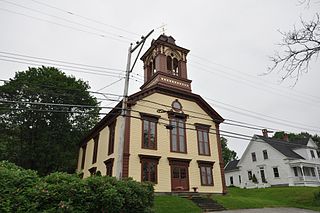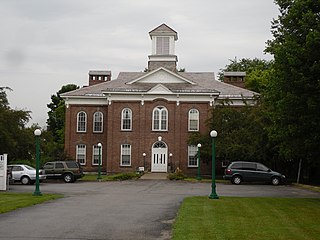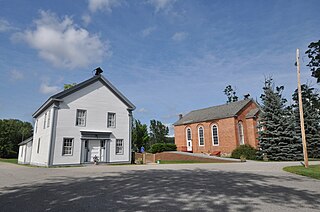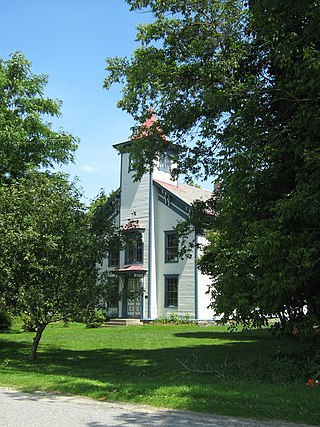
The Addison Community Baptist Church is a historic church building at 4970 Vermont Route 22A in the village center of Addison, Vermont. Built in 1816 and restyled in 1849, it is one of Vermont's oldest Baptist churches, and a good local example of Greek Revival architecture. It was listed on the National Register of Historic Places in 1978 as Addison Baptist Church.

Liberty Hall is the historic town hall of Machiasport, Maine. Located on Maine State Route 92 in the town's village center, it is a prominent local example of Italianate architecture, and has served as a civic and community meeting space for more than 100 years. It was built in 1873, and was added to the National Register of Historic Places in 1977.

Florona Grange No. 540 Hall is a historic Grange hall and former church on Monkton Road in Monkton, Vermont. Built in 1811 as the Monkton Borough Baptist Church, it is the second-oldest church in Addison County. it is a fine example of Federal architecture with later Greek Revival additions. Its initial design is based closely on designs published by Asher Benjamin. The building was added to the National Register of Historic Places in 1989.

The Enosburg Congregational Memorial Church is a historic church on Boston Post Road in Enosburg, Vermont. Built in 1820 and expanded fifty years later, it is a prominent example of ecclesiastical Italianate architecture. It was listed on the National Register of Historic Places in 2001.

The Fletcher Union Church, also known as the Fletcher Community House, is a historic former church building on TH 1 in Fletcher, Vermont. Built in 1871, it is one of only a few public buildings in the small community, and has for over a century been a secular community meeting space. It was listed on the National Register of Historic Places in 1982.
The Garland Grange Hall is a historic Grange hall on Oliver Hill Road in Garland, Maine. Built in 1891, it is one of the finest 19th-century Grange halls in the state, exhibiting a combination of Greek Revival and Italianate features. It has served as a social center for the community since its construction. It was listed on the National Register of Historic Places in 1975.

The Lakeside Grange No. 63 is a historic Grange hall on Main Street in Harrison, Maine. Built in 1905, it has served as a major community meeting space since then, notably surviving a 1907 fire that destroyed part of the town's center. It was listed on the National Register of Historic Places in 2005.
The Monticello Grange No. 338 is a historic civic building on United States Route 1 in the heart of Monticello, Maine. Built in 1922 by the local Grange organization, it served the town for many years as its only performance space, hosting social events, town meetings, and school graduations, and is still used for some of these purposes. It was listed on the National Register of Historic Places in 2000.

The Dorchester Common Historic District encompasses three public buildings that front the public common in the village of Dorchester, New Hampshire. The oldest of the three buildings is the schoolhouse, which dates to 1808 and is now a local museum. The Dorchester Community Church was built in 1828, and the town hall in 1844, on the site of the town's first (1828) town hall. The district was listed on the National Register of Historic Places in 1985; the church was also separately listed in 1980.

The North Weare Schoolhouse is a historic school building on Old Concord State Road in northern Weare, New Hampshire. Built about 1856, it is a stylistically distinctive vernacular mixing of Federal, Greek Revival, and Italianate styling. It is the most architecturally distinctive of Weare's surviving 19th-century schoolhouses. It was used as a public school until 1952, and then served as a grange hall until the 1980s. The building was listed on the National Register of Historic Places in 1995.

Pawlet Town Hall houses the municipal offices of the town of Pawlet, Vermont. Located at 122 School Street in the village center, it was built in 1881 as a combined town hall, meeting and performance venue, and retail establishment. It has served as town hall since its construction, and is a good local example of late Italianate architecture. It was listed on the National Register of Historic Places in 1995.

The Poultney Central School is a historic former school building on Main Street in the village center of Poultney, Vermont. Built in 1885, it is a high quality example of Late Victorian Italianate architecture executed in brick. It was listed on the National Register of Historic Places in 1977, and has been converted into residential use.

The Starling Grange, now Starling Hall, is an historic former Grange hall at 2769 Main Street in Fayette, Maine, US. Built in 1879, it has been a fixture of the community since then. The Grange chapter disbanded in 1987, and the building has since then been owned by the town. It was listed on the National Register of Historic Places in 2016.

The School House and Town Hall is a historic municipal building on Schoolhouse Road, just west of United States Route 7 in the center of Leicester, Vermont. Built about 1858, it is a fine example of late Greek Revival architecture, and is the town's best-preserved district schoolhouse. Its upper floor has served as the town hall since its construction. It was listed on the National Register of Historic Places in 1988.

The Waits River School is a historic school building on Vermont Route 25 in the Waits River village of Topsham, Vermont. Now a private residence, it was built in 1914 as a combination district school and Grange hall, serving in those roles until 1972 and 1953, respectively. It was listed on the National Register of Historic Places in 1988 for its Colonial Revival architecture and its importance in local educational history.

The Cornwall General Store, also known as the LaValley General Store, was a historic commercial building at 2635 Vermont Route 30 in the center of Cornwall, Vermont. Built in 1880 and in retail use for more than half a century, it was a well-preserved example of a dwindling business type, the rural general store with attached residence, listed on the National Register of Historic Places in 2005. Sold to the town for preservation in 2000, it was demolished about 2013.

The First Congregational Church of Cornwall Parsonage is a historic house at 18 Vermont Route 74 in the center of Cornwall, Vermont. Built in 1839, it is a good local example of Greek Revival architecture, and served as a parsonage until 1994. It was listed on the National Register of Historic Places in 2015.

The Jonesville Academy is a historic school building at Cochran and Duxbury Roads in Richmond, Vermont. Built about 1868, it is a prominent local example of Italianate school architecture, and was used as a school until 1955. It is now in private ownership as a residence. It was listed on the National Register of Historic Places in 1982.

Worcester Town Hall is the historic center of civic activity in Worcester, Vermont. Built in 1912 at the center of the rural community's main village, it has served since then as home to the community's town meetings, and for social gatherings and events. It was listed on the National Register of Historic Places in 2005.

The J.S. Sweeney Store, Barn, Livery and Hall were a trio of historically important commercial buildings on Vermont Route 105 in East Charleston, Vermont. Dating as far back as 1860, the general store, bank barn, and combination livery and community hall have been a center of community activity since their construction. They were listed on the National Register of Historic Places in 1992. Of the three buildings, only the store is still standing.





















